Rotary Electric Machine
UKAJI; Hajime ; et al.
U.S. patent application number 16/615379 was filed with the patent office on 2020-05-21 for rotary electric machine. The applicant listed for this patent is PANASONIC CORPORATION. Invention is credited to Katsuhiro HIRATA, Noboru NIGUCHI, Hajime UKAJI, Yuichi YOSHIKAWA.
| Application Number | 20200161948 16/615379 |
| Document ID | / |
| Family ID | 65040174 |
| Filed Date | 2020-05-21 |
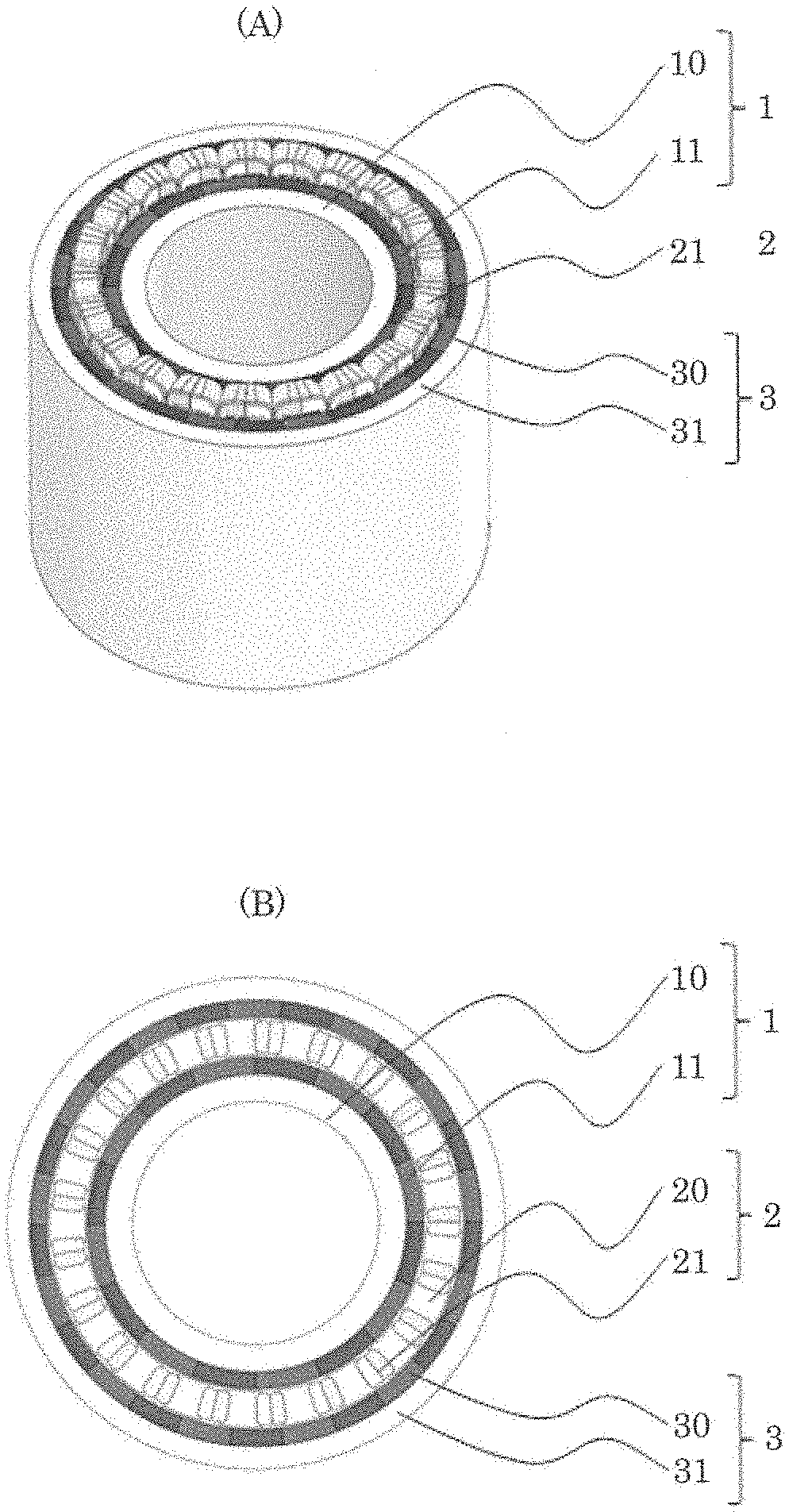
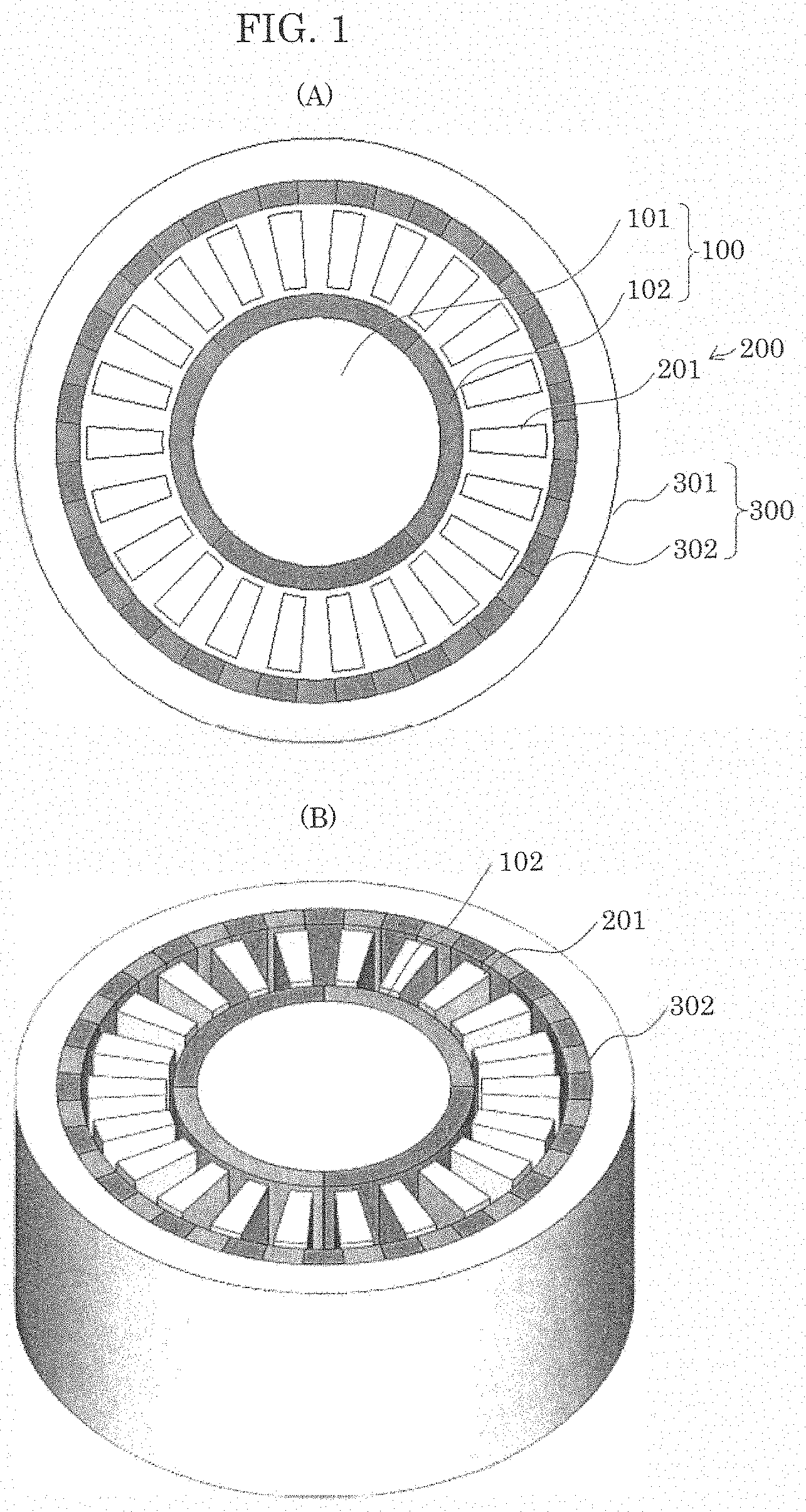

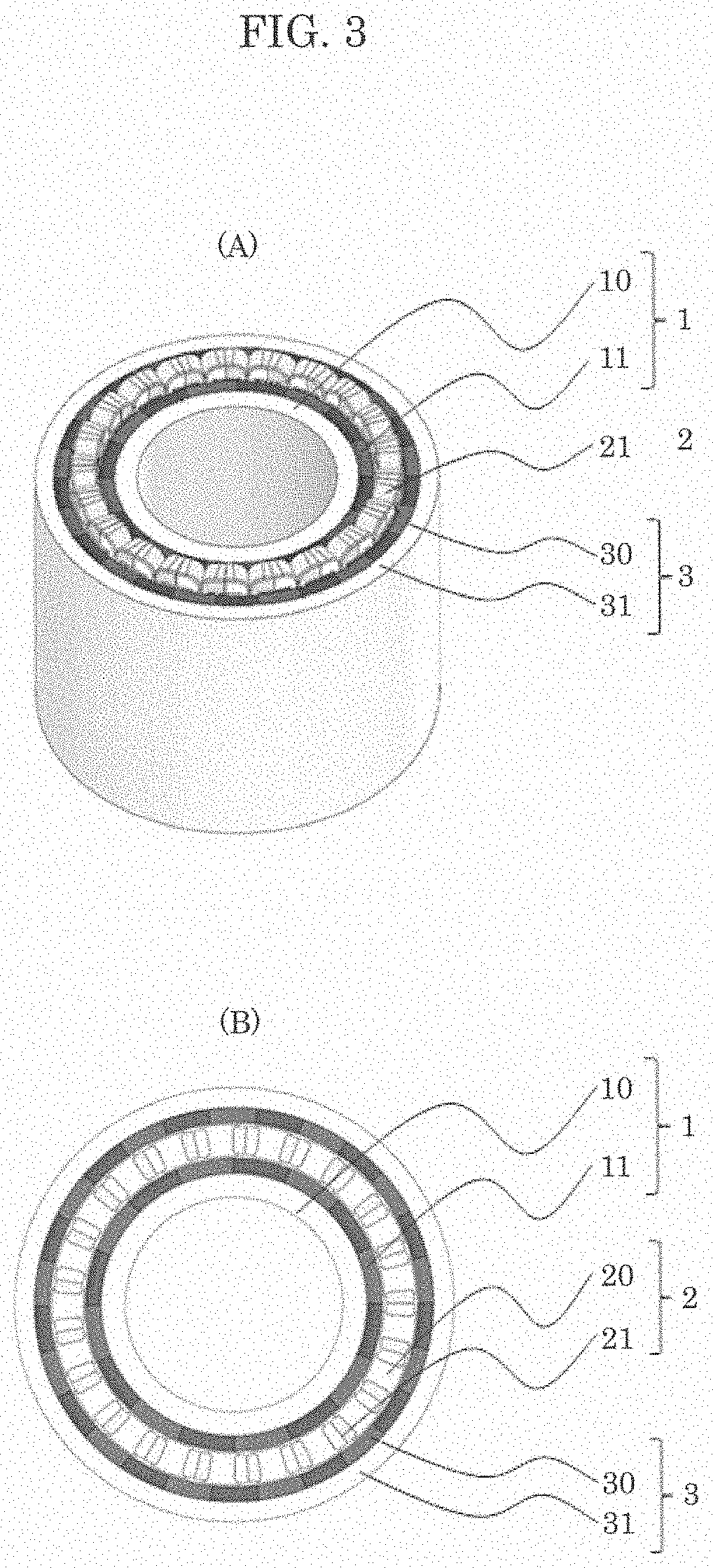
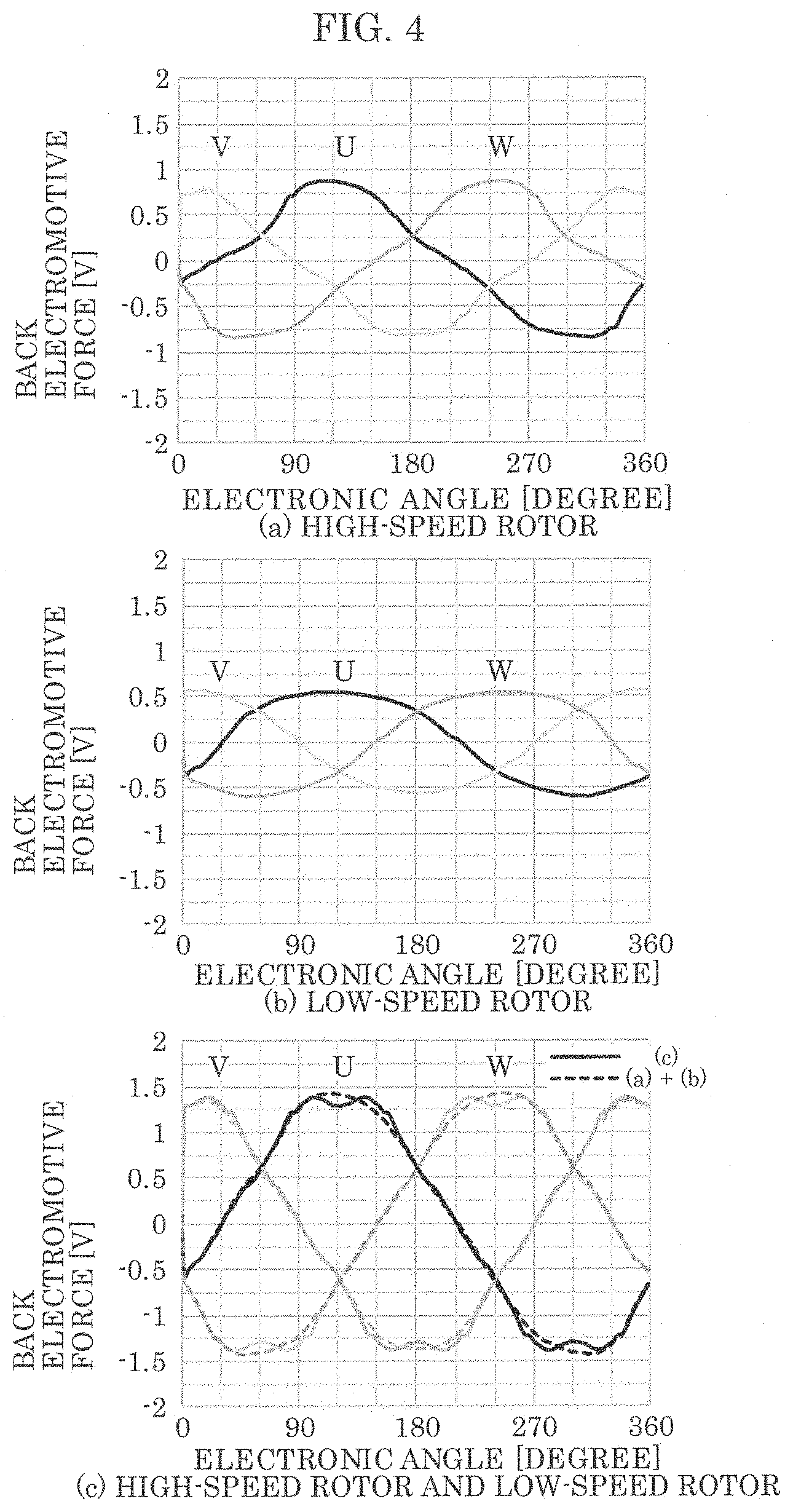
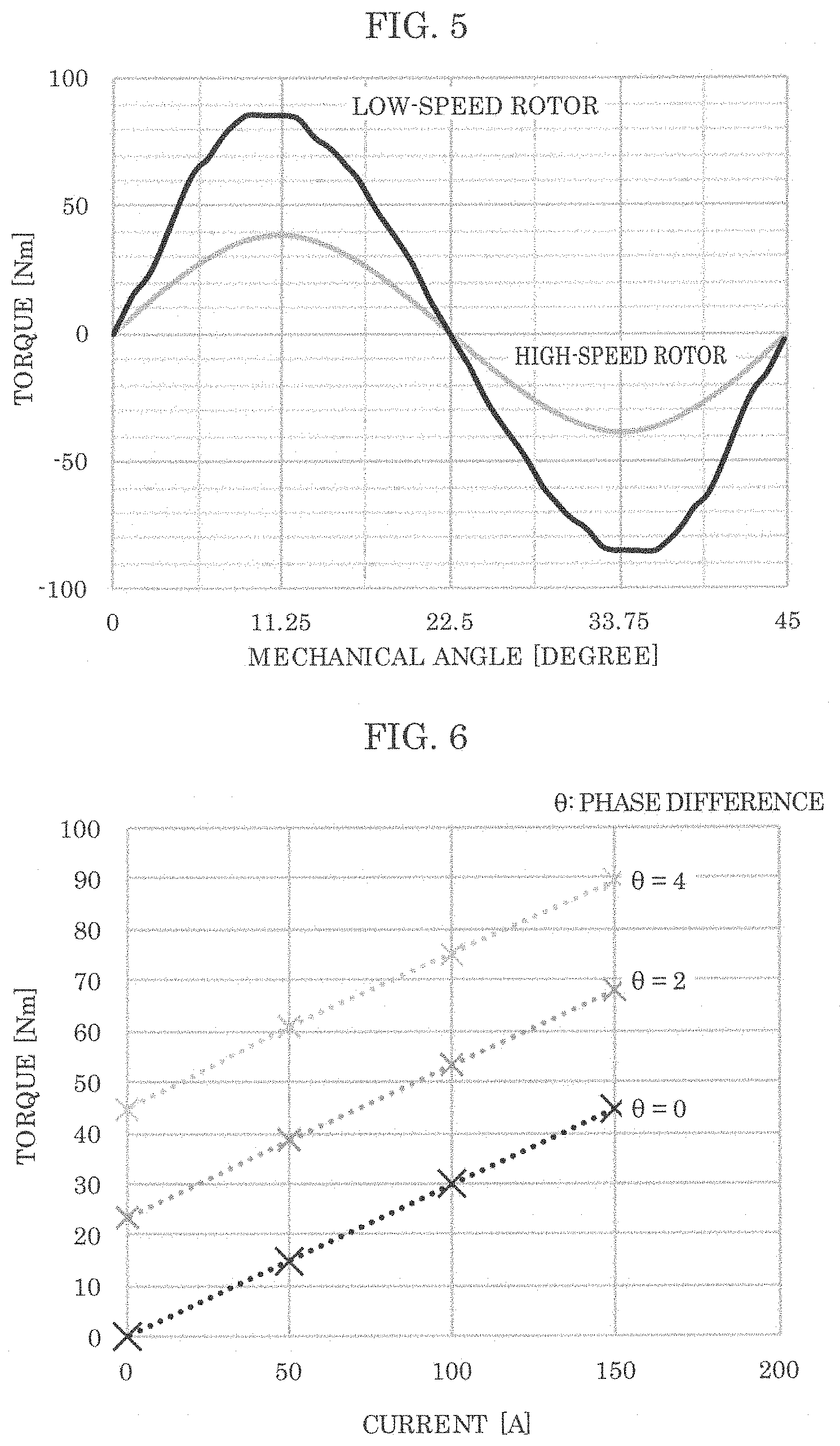
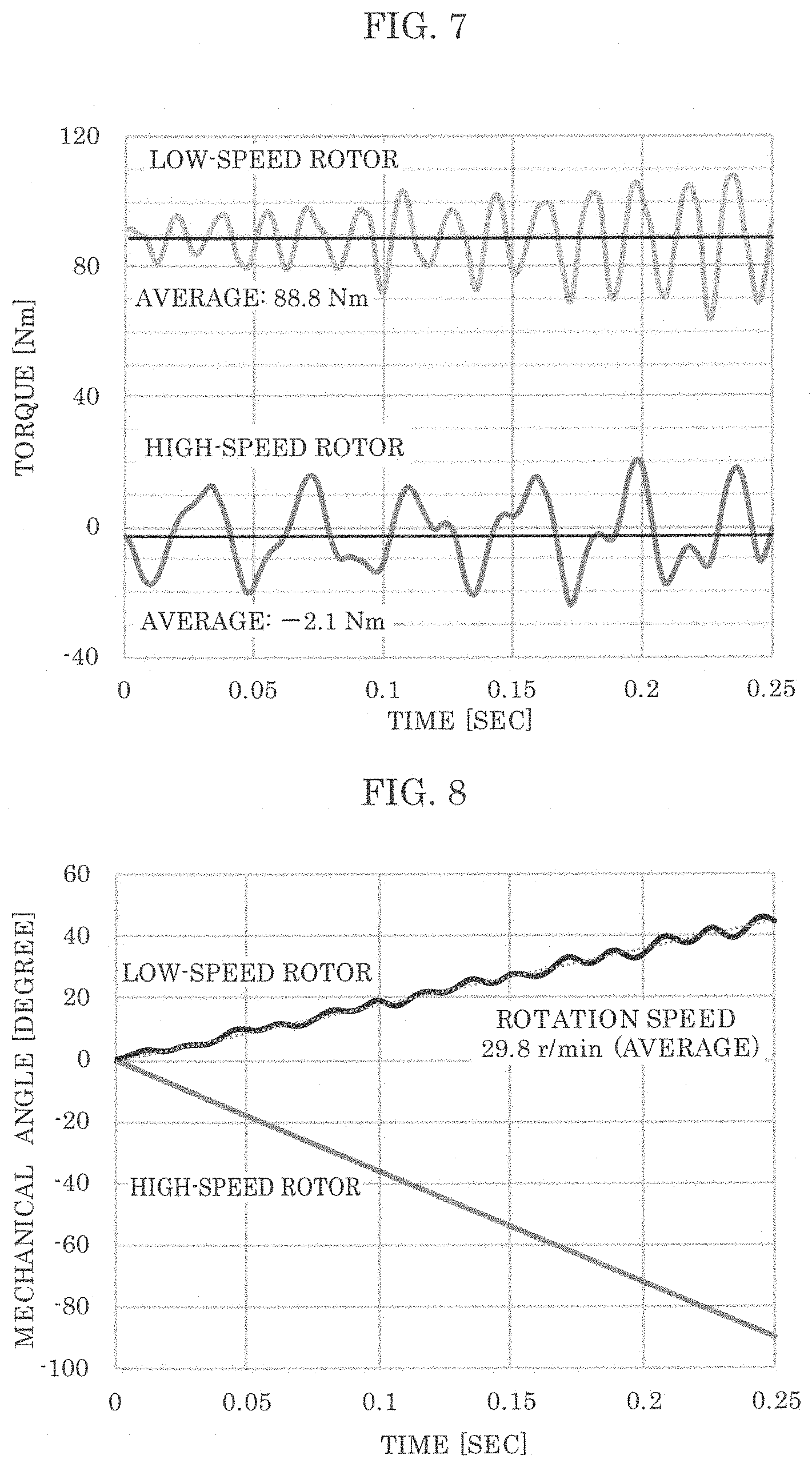

| United States Patent Application | 20200161948 |
| Kind Code | A1 |
| UKAJI; Hajime ; et al. | May 21, 2020 |
ROTARY ELECTRIC MACHINE
Abstract
A rotary electric machine includes: a first rotor, a stator, and a second rotor that are coaxially disposed in stated order from radially centermost to radially outermost and spaced apart from one another, the stator including a plurality of pole pieces and a plurality of windings in a circumferential direction. The first rotor and the second rotor each include permanent magnets or electromagnets, the plurality of windings generate electromagnetic torque in the first rotor and the second rotor, the electromagnetic torque is magnetically transferred to the second rotor by rotation of the first rotor, or magnetically transferred to the first rotor by rotation of the second rotor, and in one of the first rotor and the second rotor, torque that is magnetically transferred from an other of the first rotor and the second rotor is superimposed on the electromagnetic torque.
| Inventors: | UKAJI; Hajime; (Hyogo, JP) ; YOSHIKAWA; Yuichi; (Osaka, JP) ; HIRATA; Katsuhiro; (Osaka, JP) ; NIGUCHI; Noboru; (Osaka, JP) | ||||||||||
| Applicant: |
|
||||||||||
|---|---|---|---|---|---|---|---|---|---|---|---|
| Family ID: | 65040174 | ||||||||||
| Appl. No.: | 16/615379 | ||||||||||
| Filed: | July 25, 2018 | ||||||||||
| PCT Filed: | July 25, 2018 | ||||||||||
| PCT NO: | PCT/JP2018/027788 | ||||||||||
| 371 Date: | November 20, 2019 |
| Current U.S. Class: | 1/1 |
| Current CPC Class: | H02K 16/02 20130101; H02K 49/102 20130101; H02K 51/00 20130101; H02K 1/16 20130101; H02K 1/27 20130101; H02K 7/116 20130101; H02K 3/18 20130101; H02K 1/17 20130101; H02K 15/03 20130101 |
| International Class: | H02K 16/02 20060101 H02K016/02; H02K 7/116 20060101 H02K007/116; H02K 1/27 20060101 H02K001/27; H02K 1/16 20060101 H02K001/16; H02K 1/17 20060101 H02K001/17; H02K 15/03 20060101 H02K015/03; H02K 3/18 20060101 H02K003/18 |
Foreign Application Data
| Date | Code | Application Number |
|---|---|---|
| Jul 26, 2017 | JP | 2017-144862 |
Claims
1. A rotary electric machine, comprising: a first rotor, a stator, and a second rotor that are coaxially disposed in stated order from radially centermost to radially outermost and spaced apart from one another, the stator including a plurality of pole pieces and a plurality of windings in a circumferential direction, wherein the first rotor and the second rotor each include a magnetic material, and permanent magnets or electromagnets, the plurality of windings generate electromagnetic torque in the first rotor and the second rotor, the electromagnetic torque is magnetically transferred to the second rotor by rotation of the first rotor, or magnetically transferred to the first rotor by rotation of the second rotor, and in one of the first rotor and the second rotor, torque that is magnetically transferred from an other of the first rotor and the second rotor is superimposed on the electromagnetic torque.
2. The rotary electric machine according to claim 1, wherein one of N.sub.S=N.sub.L+N.sub.H and N.sub.S=N.sub.L-N.sub.H is satisfied when the first rotor and the second rotor are magnetically coupled, where N.sub.S denotes a total number of magnetic poles of the stator, N.sub.L denotes a total number of magnetic poles of the first rotor, and N.sub.H denotes a total number of magnetic poles of the second rotor.
3. The rotary electric machine according to claim 2, wherein the one of the first rotor and the second rotor is accelerated or decelerated when the torque that is magnetically transferred from the other of the first rotor and the second rotor is superimposed.
4. The rotary electric machine according to claim 1, wherein the one of the first rotor and the second rotor is accelerated or decelerated when the torque that is magnetically transferred from the other of the first rotor and the second rotor is superimposed.
Description
TECHNICAL FIELD
[0001] The present invention relates to a rotary electric machine having a magnetic deceleration mechanism.
BACKGROUND ART
[0002] Patent Literature (PTL) 1 and Non-patent Literature (NPL) 1 each disclose a mechanism of a rotary electric machine including a magnetic transmission mechanism. Each of the mechanism of the rotary electric machine includes, in stated order from radially centermost to radially outermost, a first rotor including permanent magnets, a second rotor including pole pieces, and a stator including a winding, and the first rotor, the second rotor, and the stator are disposed coaxially and spaced apart from one another. The first rotor is driven by applying three-phase current to the winding of the stator, and reaction torque of a magnetic reduction gear is generated in the second rotor by rotation of the first rotor. With this, a system that does not have mechanical contact and achieves low vibration, low noise, and high transmission efficiency can be obtained. In addition, the system achieves a small size or high power by combining the magnetic reduction gear and the rotary electric machine together. Moreover, the system also serves as a torque limiter by magnetically slipping when the torque exceeds allowable torque.
CITATION LIST
Patent Literature
[0003] PTL 1: Japanese Patent No. 5204094
Non-Patent Literature
[0003] [0004] NPL 1: Noboru NIGUCHI, Katsuhiro HIRATA, "A Novel Magnetic-Geared Motor", Journal of the Japan Society of Applied Electromagnetics and Mechanics, Vol. 21, No. 2 (2013), pp. 110 to 115
SUMMARY OF THE INVENTION
Technical Problem
[0005] In PTL 1 and NPL 1, torque can be generated in only one of the rotors by rotating magnetic field of the winding of the stator, and the generated torque is reduced and transmitted to the other rotor.
[0006] The present invention aims to achieve a small-sized rotary electric machine to save resources and reduce costs, and also achieve high power to increase the output of such a rotary electric machine in a limited space.
Solution to Problem
[0007] In order to solve the conventional problem, a rotary electric machine according to one aspect of the present disclosure includes: a first rotor, a stator, and a second rotor that are coaxially disposed in stated order from radially centermost to radially outermost and spaced apart from one another, the stator including a plurality of pole pieces and a plurality of windings in a circumferential direction. The first rotor and the second rotor each include a magnetic material, and permanent magnets or electromagnets, the plurality of windings generate electromagnetic torque in the first rotor and the second rotor, the electromagnetic torque is magnetically transferred to the second rotor by rotation of the first rotor, or magnetically transferred to the first rotor by rotation of the second rotor, and in one of the first rotor and the second rotor, torque that is magnetically transferred from an other of the first rotor and the second rotor is superimposed on the electromagnetic torque.
Advantageous Effect of Invention
[0008] The present invention makes it possible to achieve a rotary electric machine having a higher power density.
[0009] The effects can be obtained that two rotors generate torque by rotary magnetic field of the windings of the stator, and the torque generated in one of the rotors can be reduced and transmitted to the other rotor. These effects are advantageous in, for example, achieving a small-sized rotary electric machine to save resources and reduce costs, and also achieving high power to increase the output of such a rotary electric machine in a limited space. Thus, the rotary electric machine according to the present invention is useful.
BRIEF DESCRIPTION OF DRAWINGS
[0010] FIG. 1 illustrates a conventional magnetic deceleration mechanism, (A) is a plan view and (B) is a perspective view.
[0011] FIG. 2 illustrates a magnetic action on a conventional high-speed rotor and stator, and (A) is a plan view of pole pairs of a high-speed rotor, the pole pairs made up of permanent magnets, (B) is a graph showing magnetomotive force distribution of the permanent magnets of the high-speed rotor, (C) is a plan view of the stator, and (D) is a graph showing permeance distribution of pole pieces.
[0012] FIG. 3 is a configuration diagram of the rotary electric machine according to one embodiment of the present invention, (A) is a perspective view, and (B) is a cross-sectional view illustrating a plane of a magnetic circuit.
[0013] FIG. 4 shows analysis results of the induced voltage that is generated in windings of the stator when each rotor according to the present invention is rotated.
[0014] FIG. 5 shows an analysis result of a transmission torque that is generated due to a difference between two rotor angles (phases) according to the present invention.
[0015] FIG. 6 shows an analysis result of torque when three-phase sine-wave current is applied to the coils according to the present invention.
[0016] FIG. 7 shows torque generated in two rotors when operation verification is performed in one embodiment of the present invention.
[0017] FIG. 8 shows rotation angles of two rotors when operation verification is performed in one embodiment of the present invention.
DESCRIPTION OF EXEMPLARY EMBODIMENT
[0018] FIG. 1 and FIG. 2 are diagrams for describing a structure and the deceleration principle of a conventional magnetic deceleration mechanism. First, the deceleration principle is described with reference to these diagrams.
[0019] In FIG. 1, the conventional magnetic deceleration mechanism includes: high-speed rotor 100 that is disposed in a center portion; stator 200 that is disposed between high-speed rotor 100 and low-speed rotor 300; and low-speed rotor 300 that is disposed on the outermost circumference, all of which are disposed coaxially and spaced apart from one another. Each of the components has a predetermined length in an axis direction. High-speed rotor 100 is connected to, for example, an output axis of a motor etc. to receive torque which is not illustrated. High-speed rotor 100 includes: an iron core made of a magnetic material and having a shape of, for example, a shaft (or may be cylindrical); and pole pairs 102 made up of permanent magnets such that north poles and south poles are disposed alternately and evenly on the outer circumference of the iron core in a circumferential direction. In the example of FIG. 1, the total number of pole pairs is two. Stator 200 includes a plurality of pole pieces 201 that are bar shaped, made of a magnetic material and, extended in the axis direction, and disposed on a circumference at a predetermined pitch to face the outer circumference of pole pairs 102. Each of pole pieces 201 has a vertical cross-section that is substantially rectangle, and its planar section faces in a radial direction. Low-speed rotor 300 includes: annular body 301 made of a magnetic material and a plurality of magnetic poles 302 composed of permanent magnets disposed such that the north poles and the south poles are disposed alternately on the inner circumference of annular body 301 in the circumferential direction.
[0020] Next, in FIG. 2, now, when magnetomotive force distribution F(.theta.) of the permanent magnets (see (A) in FIG. 2) with respect to rotation direction .theta. of high-speed rotor 100 is assumed to be a sine wave as shown in (B) in FIG. 2, F(.theta.)=A sin N.sub.h.theta. can be assumed (where N.sub.h denotes the total number of pole pairs of high-speed rotor 100, and A denotes a coefficient). Moreover, when permeance distribution R(.theta.) (that shows a degree to which a material admits a flow of magnetic flux) on the outer circumference of pole piece 201 of stator 200 illustrated in (C) in FIG. 2 is also assumed to be a sine wave as shown in (D) in FIG. 2, R(.theta.)=R.sub.O+R.sub.a sin N.sub.S.theta. can be assumed (where N.sub.S denotes the total number of the pole pieces of the stator, and each of R.sub.O and R.sub.a denotes a coefficient).
[0021] Therefore, magnetic flux .phi.(.theta.) that is generated around the outer circumference of the pole piece of the stator is expressed as the following Expression (1).
[MATH 1]
.PHI.(.theta.)=F(.theta.).times.R(.theta.)=AR.sub.0 sin N.sub.h.theta.+1/2AR.sub.a{cos(N.sub.s-N.sub.h).theta.-cos(N.sub.s+N.sub.- h).theta.} (1)
[0022] In Expression (1), N.sub.h in the first term is the same component as the total number of pole pairs N.sub.b of high-speed rotor 100. N.sub.S-N.sub.h and N.sub.S+N.sub.h in the second term are harmonic components. In other words, magnetic flux .phi.(.theta.) generated around the outer circumference of the pole pieces of the stator includes two types of harmonic components N.sub.S-N.sub.h and N.sub.S+N.sub.h, other than basic component (main component) N.sub.h.
[0023] Next, when the case where high-speed rotor 100 is rotated by .DELTA..theta. while the stator is fixed is considered, the magnetomotive force distribution at this time is F(.theta.+.DELTA..theta.). On the other hand, the permeance distribution is R(.theta.), because the stator does not rotate. Magnetic flux .phi.(.theta.+.DELTA..theta.) around the outer circumference of the pole pieces of the stator when the high-speed rotor is rotated by .DELTA..theta. is expressed as the following Expression (2).
[ MATH 2 ] .phi. ( .theta. + .DELTA. .theta. ) = F ( .theta. + .DELTA. .theta. ) .times. R ( .theta. ) = A R 0 sin N h ( .theta. + .DELTA. .theta. ) + 1 2 AR a { cos ( N s - N h ) ( .theta. - N h N s - N h .DELTA. .theta. ) - cos ( N s + N h ) .theta. + N h N s + N h .DELTA. .theta. ) } ( 2 ) ##EQU00001##
[0024] In Expression (2), since N.sub.h in the first term of magnetic flux .phi.(.theta.+.DELTA..theta.) is (.theta.+.DELTA..theta.), i.e., +.DELTA..theta. component is present, N.sub.h is a component rotating at the same speed as high-speed rotor 100. On the other hand, N.sub.S-N.sub.h and N.sub.S+N.sub.h in the second term are both harmonics having different speeds from the speed of high-speed rotor 100. In other words, N.sub.S-N.sub.h rotates by -N.sub.h.DELTA..theta./(N.sub.S-N.sub.h) with respect to the rotation by .DELTA..theta. of high-speed rotor 100. Moreover, regarding N.sub.s+N.sub.h, since the rotation is performed by N.sub.h.DELTA..theta./(N.sub.S+N.sub.h) with respect to the rotation by .DELTA..theta. of the high-speed rotor, both of the rotation speeds differ from the basic component. When the total number of magnetic poles of low-speed rotors 300 is set to either N.sub.S-N.sub.h or N.sub.S+N.sub.h, low-speed rotor 300 will rotate at a different rotation speed with respect to the total number of magnetic poles that is set.
[0025] In order to achieve that, when N.sub.l denotes the total number of magnetic poles of low-speed rotor 300, N.sub.l is set to satisfy N.sub.l=N.sub.S-N.sub.h, or N.sub.l=N.sub.S+N.sub.h. In other words, when these expressions are rewritten, N.sub.S=N.sub.l+N.sub.h, or N.sub.S=N.sub.l-N.sub.h (i.e., N.sub.S=N.sub.l.+-.N.sub.h). These will be conditions for establishing a magnetic deceleration mechanism.
[0026] Moreover, reduction ratio G.sub.r is G.sub.r=.+-.N.sub.l/N.sub.h. Note that when reduction ratio G.sub.r is positive, it indicates that high-speed rotor 100 and low-speed rotor 300 rotate in the same direction. When reduction ratio G.sub.r is negative, it indicates that high-speed rotor 100 and low-speed rotor 300 rotate in opposite directions. However, a driving source that mechanically rotates the stator is necessary, i.e, typically, adding a motor is necessary, for example. Thus, new problems will arise, for example, the mechanism will be complicated, increase in size, and expensive.
EMBODIMENT
[0027] In view of the above, in the present invention, windings are provided to the pole pieces of the stator of the conventional magnetic deceleration mechanism illustrated in FIG. 1. The present invention provides a rotary electric machine that is capable of generating torque in two rotors.
[0028] A rotary electric machine according to one embodiment (FIG. 3) of the present invention includes, in stated order from outermost to centermost, low-speed rotor 3 that includes magnetic material 31 and permanent magnets 30; stator 2 that includes coils 21 wound around pole pieces 20; and high-speed rotor 1 that includes permanent magnets 11 and magnetic material 10. Here, high-speed rotor 1 and low-speed rotor 3 are examples of the first rotor and the second rotor, respectively, and the operating principle works even if high-speed rotor 1 and low-speed rotor 3 are interchanged with each other. However, in the present embodiment, low-speed rotor 3 that is multipolar is disposed on the outer side. Moreover, although coils 21 wound around pole pieces 20 are wound by short-pitch concentrated winding, the winding method is not limited to this method.
[0029] As described above, the rotary electric machine according to the embodiment includes: a first rotor, stator 2, and a second rotor that are coaxially disposed in stated order from radially centermost to radially outermost and spaced apart from one another, stator 2 including a plurality of pole pieces 20 and a plurality of windings (coils 21) in a circumferential direction. The first rotor includes magnetic material 10, and permanent magnets 11 or electromagnets. The second rotor includes magnetic material 31, and permanent magnets 30 or electromagnets. The plurality of windings generate electromagnetic torque in the first rotor and the second rotor, the electromagnetic torque is magnetically transferred to the second rotor by rotation of the first rotor, or magnetically transferred to the first rotor by rotation of the second rotor, and in one of the first rotor and the second rotor, torque that is magnetically transferred from an other of the first rotor and the second rotor is superimposed on the electromagnetic torque.
[0030] Next, the operating principles of the present invention will be described. It is a premise that the total number of pole pairs of high-speed rotor 1, the total number of pole pairs of low-speed rotor 3, and the total number of pole pieces of stator 2 fulfill the conditions for establishing the magnetic deceleration mechanism described above. In other words, one of N.sub.S=N.sub.L+N.sub.H and N.sub.S=N.sub.L-N.sub.H is satisfied when the first rotor and the second rotor are magnetically coupled, where N.sub.S denotes the total number of magnetic poles of stator 2, N.sub.L denotes the total number of magnetic poles of the first rotor, and N.sub.H denotes the total number of magnetic poles of the second rotor. When high-speed rotor 1 rotates at rotation speed .omega..sub.H, frequency F.sub.H of the back electromotive force generated in coils 21 of stator 2 is N.sub.H.omega.H. On the other hand, rotation speed .omega..sub.L of low-speed rotor 3 is .omega..sub.H/G.sub.r, and frequency F.sub.L of the back electromotive force generated in coils 21 of stator 2 by the rotation of low-speed rotor 3 is N.sub.L.omega.L=(G.sub.rN.sub.H)(.omega..sub.H/G.sub.r)=F.sub.H. Accordingly, the frequency of the back electromotive force generated in coils 21 of stator 2 by rotation of high-speed rotor 1 and the frequency of the back electromotive force generated in coils 21 of stator 2 by rotation of low-speed rotor 3 are the same. Here, high-speed rotor 1 and low-speed rotor 3 are included in the rotary electric machine according to the present invention that fulfills the conditions for establishing the magnetic deceleration mechanism. Therefore, when the conditions for establishing the magnetic deceleration mechanism are fulfilled, and high-speed rotor 1 and the total number of pole pieces of stator 2, and low-speed rotor 3 and the total number of pole pieces of stator 2 is a combination that can cause, for example, a three-phase permanent magnet brush-less motor to rotate, torque is generated in both rotors by the current applied to coils 21 of stator 2.
[0031] It is assumed that low-speed rotor 3 rotates constantly at .omega..sub.L. When frequency .phi..sub.H and electric current I are applied to coils 21 of stator 2, torque T.sub.H that is generated in high-speed rotor 1 is T.sub.H=k.sub.tHI when torque constant k.sub.tH is used, and torque T.sub.L that is generated in low-speed rotor 3 is T.sub.L=k.sub.tLI when torque constant k.sub.tL is used.
[0032] The torque generated in high-speed rotor 1 by the electric current of coils 21 is equal to the reaction torque from low-speed rotor 3 that is generated by operation as a magnetic reduction gear, and the torque is multiplied by the reduction ratio and transmitted to the low-speed rotor. Therefore, when a loss is disregarded, torque T.sub.O outputted from low-speed rotor 3 is T.sub.O=T.sub.L+G.sub.rT.sub.H and it can be understood that the electromagnetic torque generated in low-speed rotor 3 by the windings of the stator, and the torque that is magnetically transferred from high-speed rotor 1 are superimposed on each other. In other words, one of the first rotor and the second rotor can be accelerated or decelerated when the torque that is magnetically transferred from the other of the first rotor and the second rotor is superimposed.
[0033] Next, the magnetic deceleration structure model was created based on this principle, and an effect test was simulated. Note that a model of the rotary electric machine is created using the following elements.
[0034] The total number of pole pairs of the high-speed rotor: 4
[0035] The total number of pole pairs of the low-speed rotor: 8
[0036] The total number of pole pieces of the stator: 12
[0037] Reduction ratio: -2 (=-8/4)
[0038] The outermost diameter: 110 mm
[0039] The length in the axis direction: 80 mm
[0040] The number of turns of the coils: 10
[0041] Magnetization of the permanent magnet: 1.28 T
[0042] First, in order to check whether torque is generated in each of the high-speed rotor and low-speed rotor by applying electric current to the coils of the stator, a counter electromotive voltage when the high-speed rotor and the low-speed rotor are rotated in accordance with the reduction ratio is checked.
[0043] The back electromotive force generated in the coils of the stator under each of conditions (a), (b), and (c) listed below was obtained.
[0044] (a) Fix the low-speed rotor, and forcibly rotate the high-speed rotor at -60 r/min.
[0045] (b) Fix the high-speed rotor, and forcibly rotate the high-speed rotor at 30 r/min.
[0046] (c) Forcibly rotate the high-speed rotor at -60 r/min and forcibly rotate the low-speed rotor at 30 r/min.
[0047] The results are shown in FIG. 4. The voltage phases of the back electromotive force generated under conditions (a) and (b) are equal, and the back electromotive force generated under condition (c) in which both rotors were rotated in accordance with the reduction ratio is equal to the sum of the back electromotive force generated under conditions (a) and (b). Therefore, it can be understood that torque can be generated in each of the high-speed rotor and low-speed rotor by applying three-phase sine-wave current to the coils of the stator.
[0048] Next, in order to check whether the torque of the high-speed rotor is transmitted to the low-speed rotor as the magnetic transmission mechanism, the high-speed rotor was fixed, the low-speed rotor was forcibly rotated from a magnetically stable position, and transmission torque generated according to the difference between two rotor angles (phase difference) from the magnetically stable position was obtained. This result is shown in FIG. 5. The maximum transmission torque of both rotors is generated when the phase difference is approximately 11.25 degrees, and the maximum transmission torque of the high-speed rotor and the maximum transmission torque of the low speed rotor are 38.6 Nm and 85.8 Nm, respectively. Although this shows that the torque generated by the low-speed rotor and the torque generated by the high-speed rotor are almost equal to the reduction ratio, the difference with respect to the theoretical value occurs due to cogging torque.
[0049] In order to check the effect of superimposing the torque, the high-speed rotor was forcibly rotated at -60 r/min, the low-speed rotor was forcibly rotated at 30 r/min, sine-wave current was applied, and the torque of the low-speed rotor when the phases of the high-speed rotor and the low-speed rotor was changed was obtained. This result is shown in FIG. 6. Regardless of the phase difference, the torque of the low-speed rotor increased with the increasing electric current. When the phase difference was set to 4 degrees and the magnetomotive force with an amplitude of 150 A was applied to the coils, the torque of the low-speed rotor was 89 Nm, and the torque increased by 44 Nm compared with the torque when the electric current is not applied.
[0050] In the rotary electric machine according to the present invention, the torque of the low-speed rotor when the current is not applied is equivalent to the transmission torque generated due to the phase difference with respect to the high-speed rotor. This can be achieved also in a rotary electric machine with a conventional magnetic deceleration mechanism. Since the torque of the low-speed rotor increases with the increasing electric current in the state where the phase difference is constant, the reaction torque received from the high-speed rotor that serves as a magnetic reduction gear is superimposed on the torque generated in the low-speed rotor by the reaction torque generated by magnetomotive force of the coils.
[0051] Lastly, in order to verify the operation, the initial phase difference is set to 4 degrees, and the operation when the magnetomotive force with an amplitude of 150 A is applied to the coils is verified. Here, the high-speed rotor was rotated at 60 r/min, and electric current is inputted according to rotation positions of the high-speed rotor. At this time, load L=89.5 Nm was applied to the low-speed rotor, and the torque generated in each rotor and the number of rotations of the low-speed rotor were obtained. This result is shown in FIGS. 7 and 8.
[0052] The average torque of the high-speed rotor was -2.1 Nm and the average torque of the low-speed rotor was 88.8 Nm as shown in FIG. 7, and the average rotation speed of the low-speed rotor was 29.8 r/min as shown in FIG. 8. Although the average torque of the high-speed rotor should be theoretically zero, torque ripple and a time period in which averaging processing is performed influence the average torque, and thus the average torque of the high-speed rotor is not zero. The ratio of rotation speed between both rotors is approximately equal to the reduction ratio. Lastly, the torque of the low-speed rotor fluctuates around approximately 89 Nm, and has hardly changed since the time zero. This indicates that the phase difference between both rotors maintains an average of 4 degrees, and torque is generated in the low-speed rotor by the magnetomotive force of 150 A, as understood from FIG. 5. In other words, the reaction torque in a magnetic reduction gear is superimposed on the torque generated by the coil current, and is outputted from the low-speed rotor.
[0053] While the rotary electric machine according to the present disclosure has been described above, the present disclosure is not limited to the embodiment described above.
[0054] The scope of the present disclosure may also include embodiments as a result of adding various modifications to the embodiment that may be conceived by those skilled in the art, and embodiments obtained by combining the structural elements and functions in the embodiment in any manner as long as the combination does not depart from the scope of the present disclosure.
INDUSTRIAL APPLICABILITY
[0055] The present disclosure can be used for rotary electric machines in general that have a magnetic deceleration mechanism.
REFERENCE MARKS IN THE DRAWINGS
[0056] 1, 100 high-speed rotor [0057] 2 stator [0058] 3, 300 low-speed rotor [0059] 10, 31 magnetic material [0060] 11, 30 permanent magnet [0061] 20, 201 pole piece [0062] 21 coil [0063] 102 pole pair [0064] 200 stator
* * * * *
uspto.report is an independent third-party trademark research tool that is not affiliated, endorsed, or sponsored by the United States Patent and Trademark Office (USPTO) or any other governmental organization. The information provided by uspto.report is based on publicly available data at the time of writing and is intended for informational purposes only.
While we strive to provide accurate and up-to-date information, we do not guarantee the accuracy, completeness, reliability, or suitability of the information displayed on this site. The use of this site is at your own risk. Any reliance you place on such information is therefore strictly at your own risk.
All official trademark data, including owner information, should be verified by visiting the official USPTO website at www.uspto.gov. This site is not intended to replace professional legal advice and should not be used as a substitute for consulting with a legal professional who is knowledgeable about trademark law.